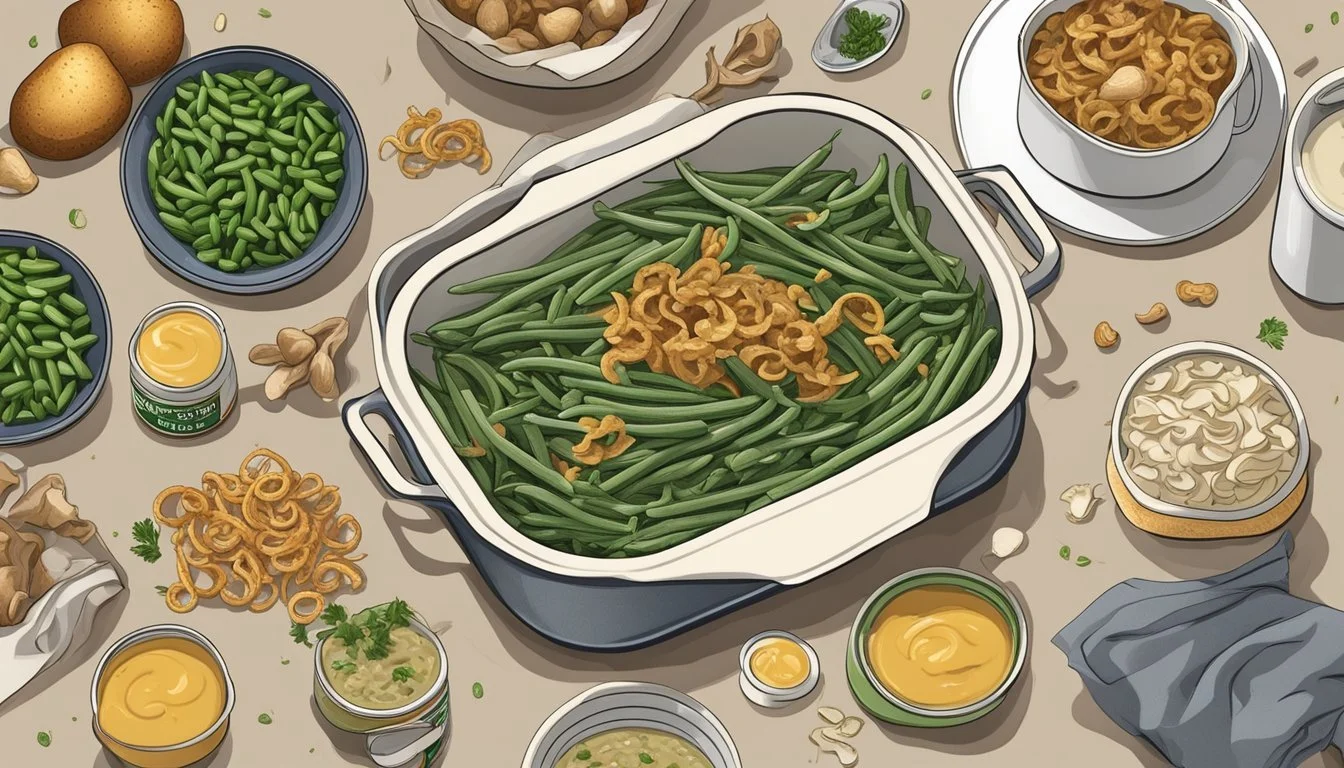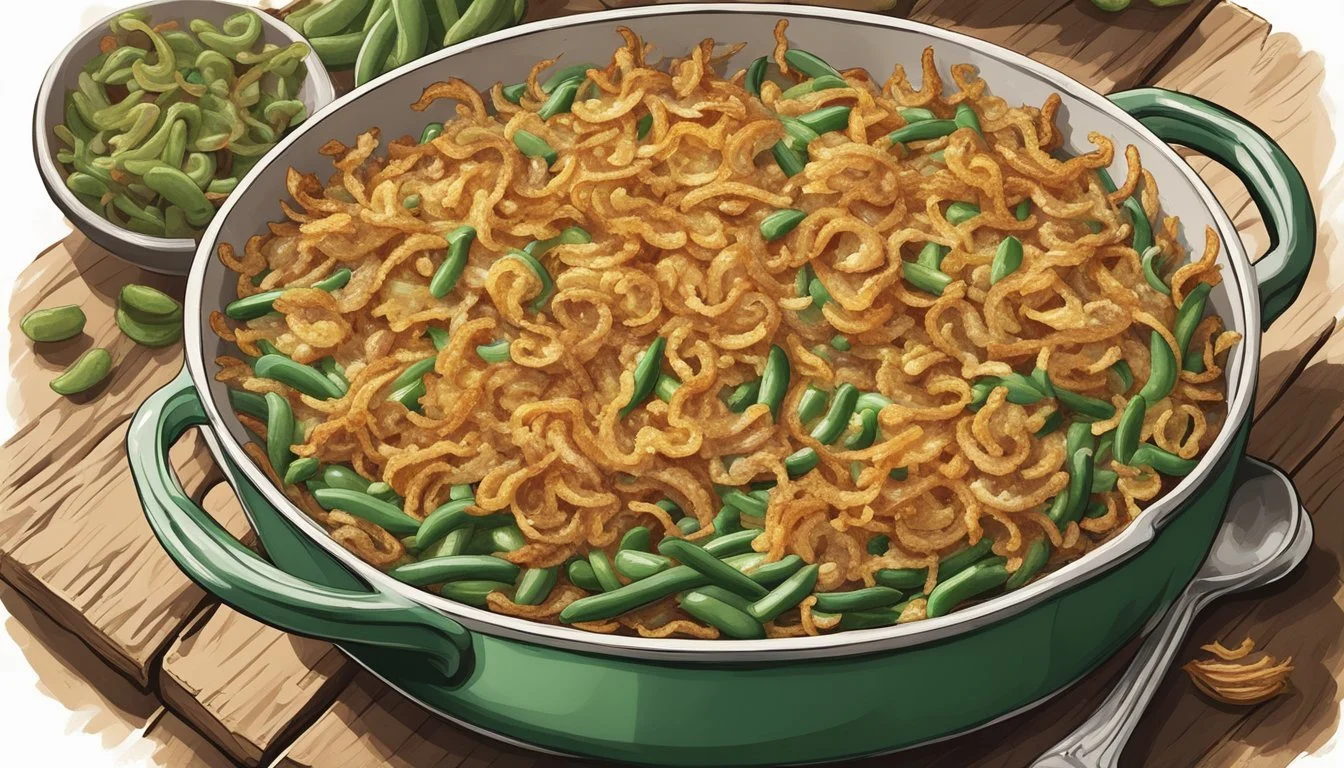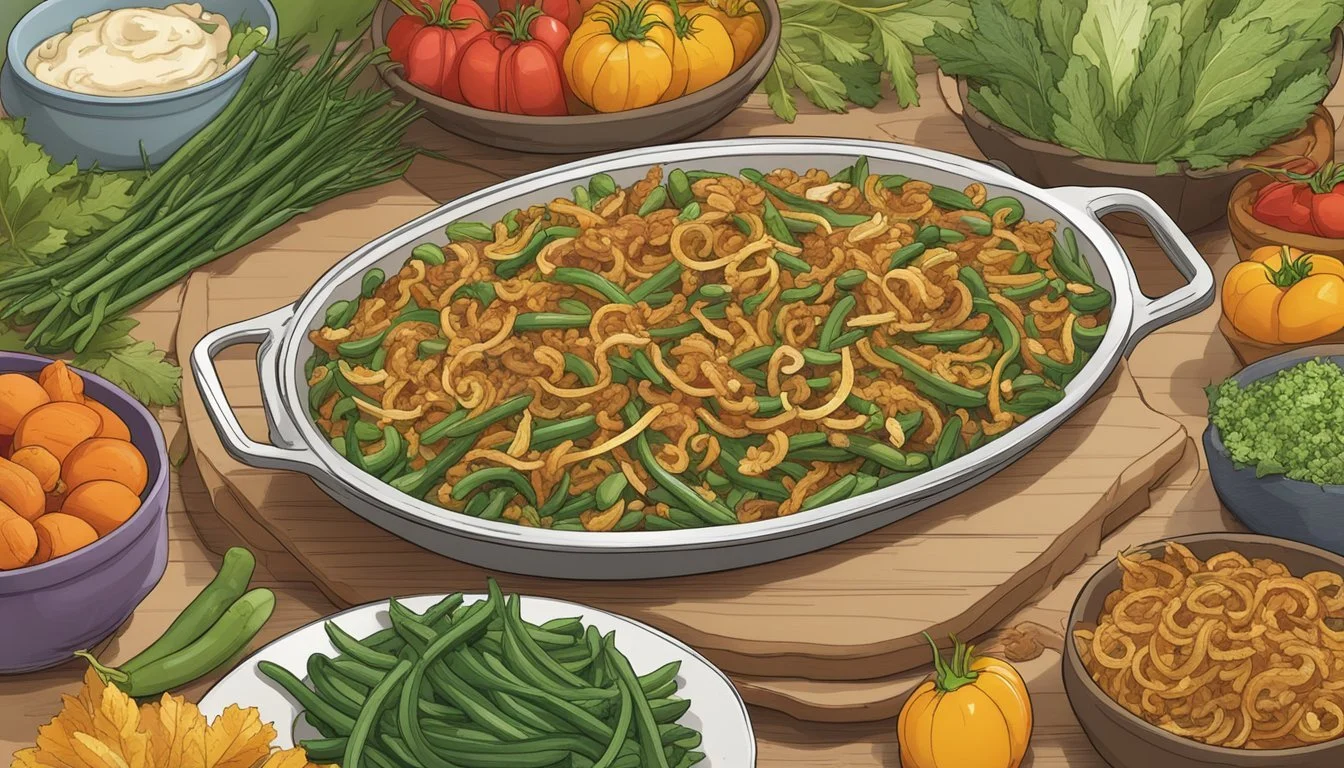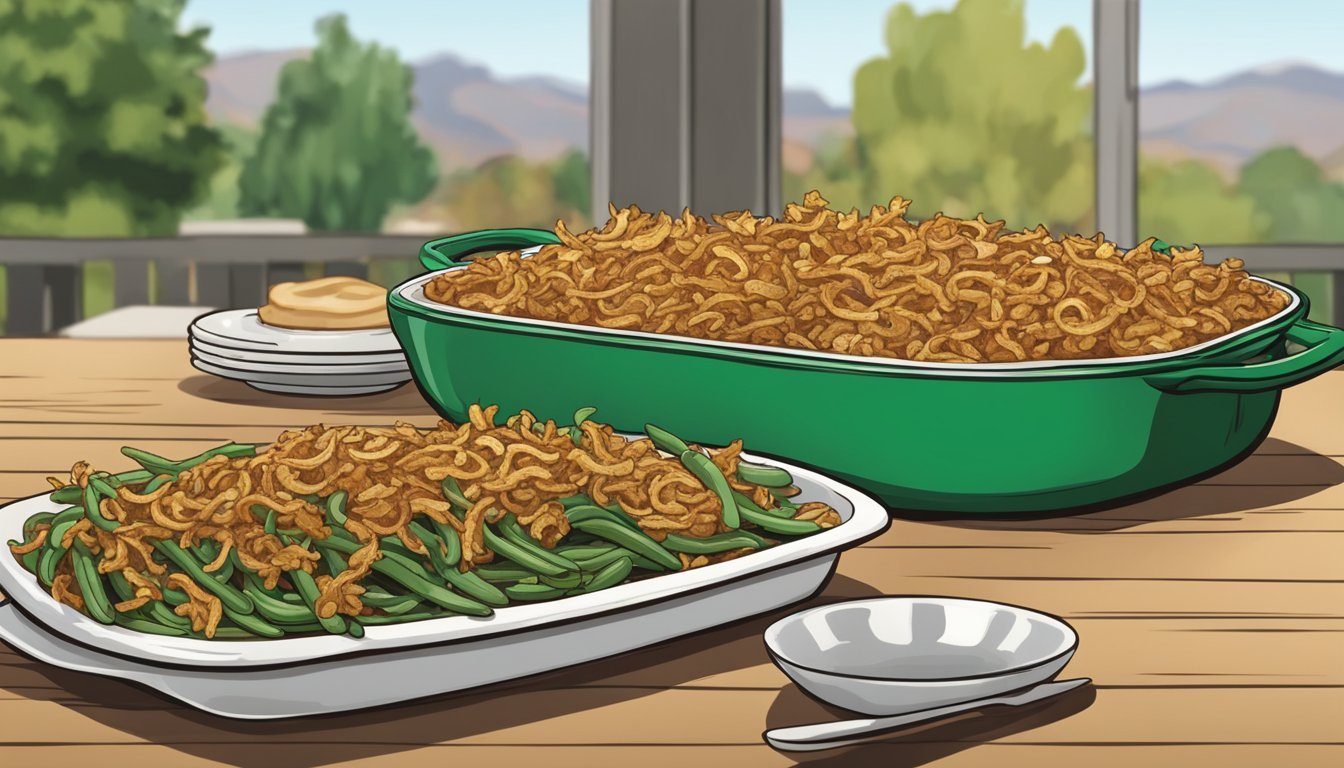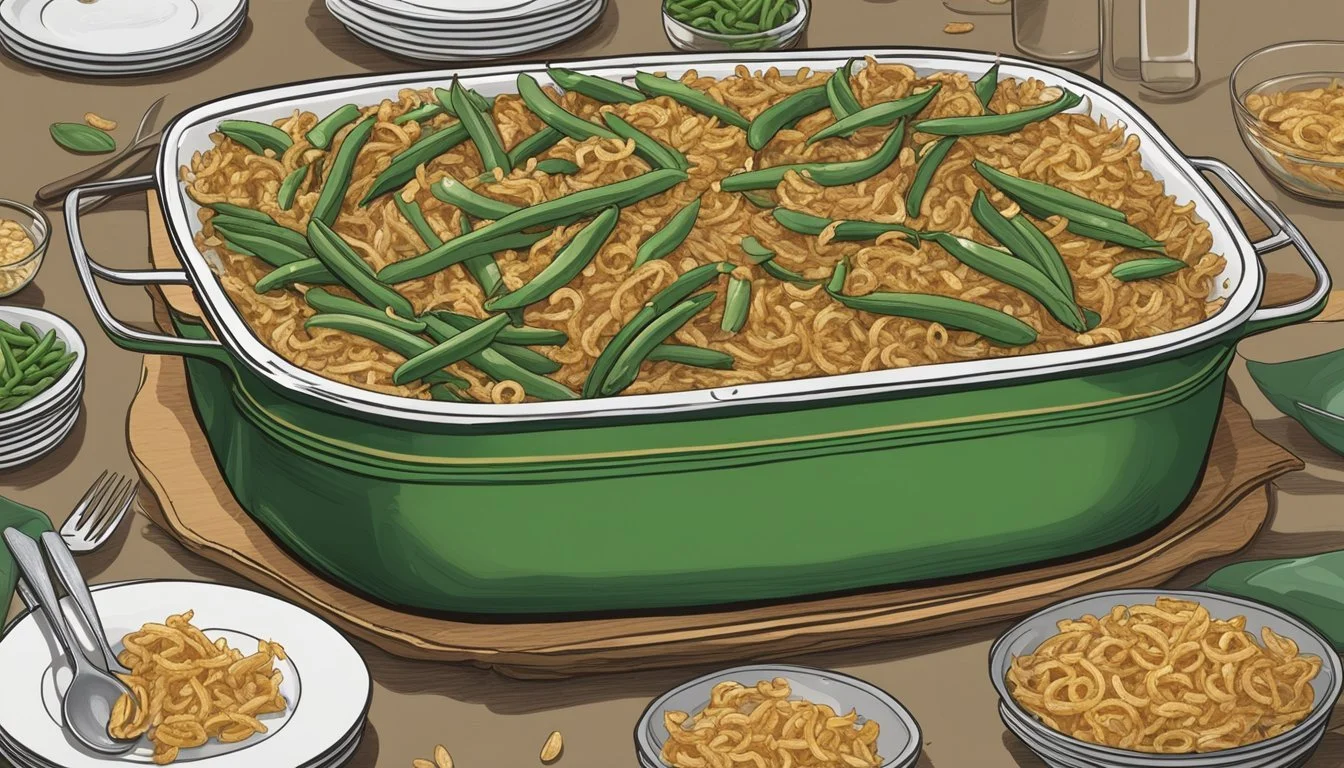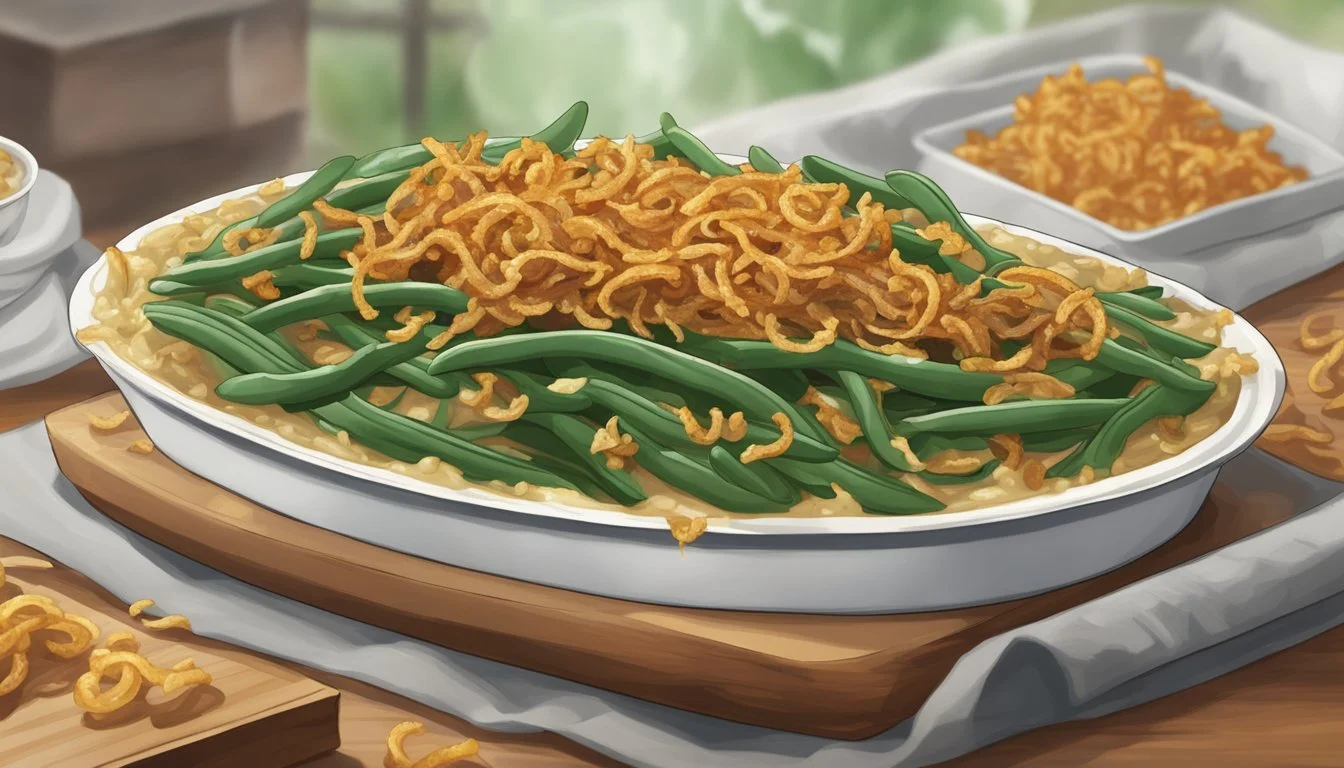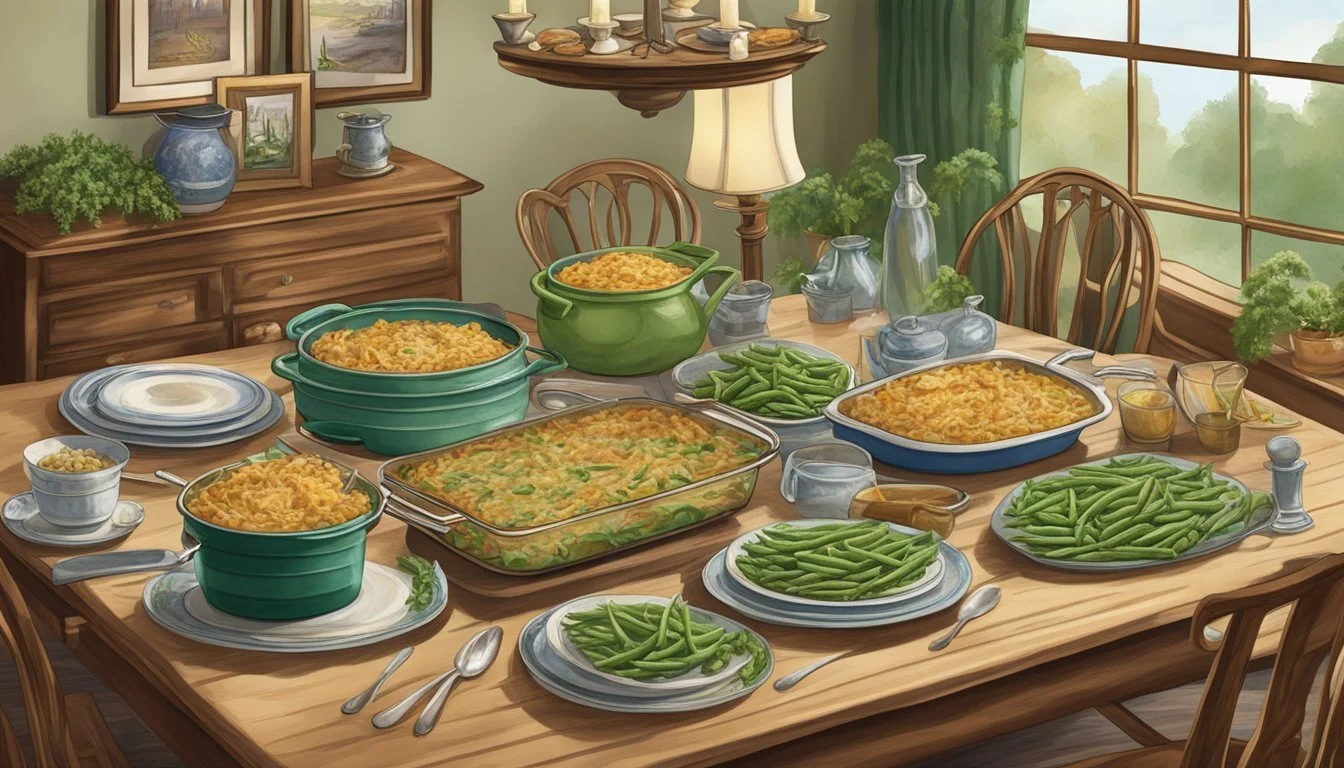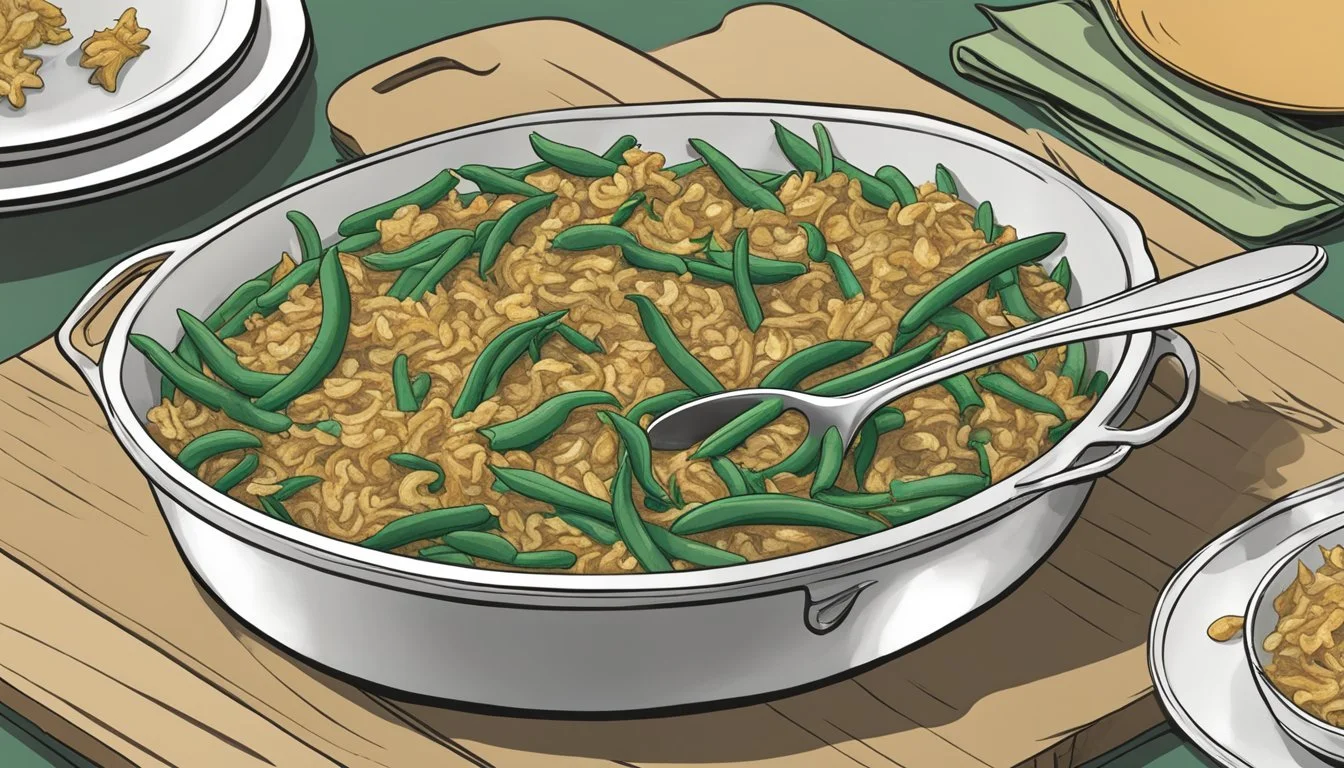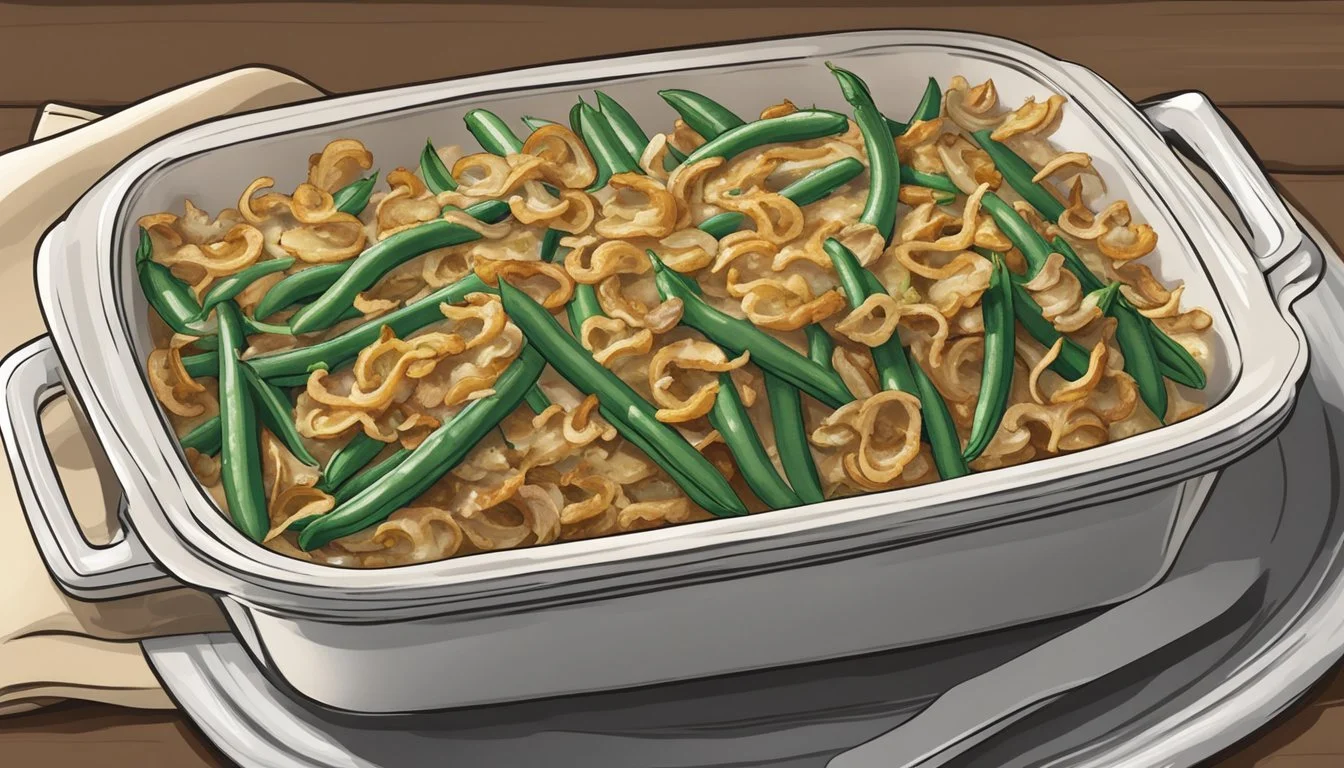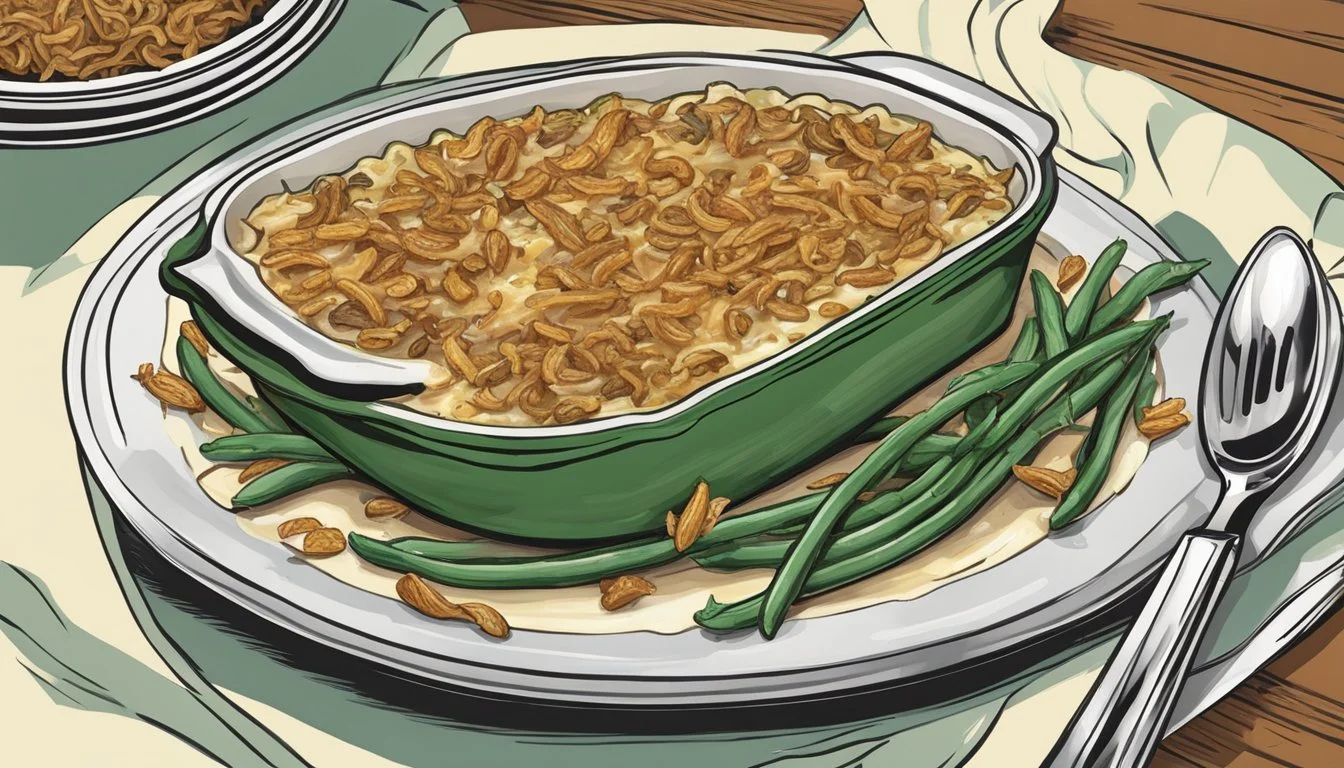How do you eat a green bean casserole?
Mastering the Art of Enjoying This Classic Dish
Eating green bean casserole is a tradition for many, especially during Thanksgiving gatherings. This iconic dish combines green beans with creamy soup, typically mushroom, and is often topped with crispy fried onions. (What wine goes well with onions?) It presents a mix of textures from the soft beans to the crunchy onions, offering a rich, savory flavor profile that complements a variety of main courses.
While the dish itself is a staple at holiday feasts, the manner in which it is served and consumed can vary. It is usually scooped alongside other sides onto a dinner plate, but portion sizes and accompaniments can differ based on personal preference. Some might enjoy it with a spoonful of cranberry sauce while others might prefer it as is.
Green bean casserole can also be customized to suit different tastes, suggesting its versatility. For those who prefer a bit of a twist, ingredients like cheese, bacon, or almonds might be added. Despite these variations, the essential steps of baking the mixture until hot and bubbly, and achieving a golden brown topping remain standard to ensure the casserole's characteristic texture and taste.
Essential Ingredients
The quintessential green bean casserole is composed of a few staple ingredients: green beans, mushroom soup, and onions. Each component has variations allowing for customization based on personal preference or availability.
Green Beans Varieties
Canned Green Beans: Typically used for convenience, canned green beans are pre-cooked and can be incorporated directly into the casserole.
Frozen Green Beans: They must be thawed before use, often offering a fresher taste and firmer texture compared to their canned counterparts.
Mushroom Soup Types
Cream of Mushroom Soup: A common base for the casserole, it provides creaminess and depth of flavor.
Homemade Mushroom Soup: Individuals may opt for a homemade version using cremini mushrooms or other varieties to enhance the casserole's earthy flavor profile.
Onion Preparation Options
French Fried Onions: A classic topping that offers a delightful crunch and onion flavor; added in layers during baking and as a finishing garnish.
Fresh Onions: They can be sautéed until soft and translucent to mix into the casserole or to create a homemade crispy onion topping.
Preparation Techniques
Creating a delightful green bean casserole involves precise preparation steps, from handling the beans to creating a well-blended soup base and preparing the perfect crispy onion topping.
Bean Prepping Methods
Proper bean preparation is crucial to the texture and flavor of the casserole. The beans should be first trimmed of their ends, then halved if desired. A blanching process is often employed, where beans are boiled in salted water until crisp-tender—typically for about 3-4 minutes. After blanching, they should be immediately submerged in an ice water bath to halt cooking, preserving their vibrant color and desired texture.
Mushroom Soup Blending
The base of the green bean casserole is typically a creamy cream of mushroom soup. For a well-balanced base, one should combine the soup with milk—to adjust the consistency—along with salt and black pepper for seasoning. The blend should be well-stirred to ensure homogeneity. This seasoned mixture serves as the binding agent that integrates the flavors and coats the beans evenly.
Onion Frying Fundamentals
Crispy fried onions are the signature topping of a green bean casserole, providing a contrasting texture. When frying onions, one should aim for a golden brown finish, which signifies a crispy exterior with a tender interior. Sodium control can be managed by seasoning lightly, as the onions will also absorb flavors from the casserole. They're generally added in two stages—folded into the bean mixture before baking and then added as a final topping during the last minutes of baking to ensure a crunchy texture.
Assembling the Dish
To ensure a successful green bean casserole, precision in layering the ingredients and adherence to the baking process is essential. The following subsections detail how one should assemble the dish to achieve the perfect balance of flavors and textures.
Layering Ingredients
The green bean casserole begins with preparing a baking dish, typically 9x13 inches in size. The maker starts by spreading a portion of the creamy mushroom sauce on the bottom of the dish. Next, they add the pre-cooked green beans—ideally tender but still vibrant in color—ensuring they are evenly distributed. On top of the beans, the cook layers fried onions, which add a crucial textural contrast and savory flavor.
Baking Process
The casserole is baked in an oven, typically preheated to between 325°F and 375°F. It is crucial to bake the dish uncovered to allow the top to become crisp and golden brown. The baking time varies but usually takes approximately 25 to 30 minutes. A good indicator that the casserole is ready is when the sauce is bubbly, and the fried onions on top have developed a rich, golden brown color, signaling a crunchy finish.
Casserole Variations
Green bean casserole can be tailored to suit different dietary needs and flavor preferences. From classic recipes to creative twists, one can craft a dish that satisfies everyone at the table.
Dietary Modifications
For those with dietary restrictions, easy green bean casserole variations are readily adaptable. One can switch to gluten-free fried onions or skip them entirely for a gluten-free version. A classic green bean casserole can be transformed into a vegetarian dish by using mushroom soup instead of cream of chicken and omitting bacon or pancetta. To meet dairy-free requirements, cooks can substitute the creamy sauce with a dairy-free alternative and exclude cheese.
Gluten-Free: Use gluten-free fried onions or almond flour for topping.
Vegetarian: Replace cream of chicken with mushroom soup; omit meat products.
Dairy-Free: Utilize dairy-free creamy sauce options and skip on the shredded cheddar cheese.
Flavor Enhancements
For those aiming to elevate the traditional green bean casserole, various ingredients can be introduced:
Bacon: Incorporating crispy bacon adds a savory crunch.
Pancetta: Pancetta offers a saltier, more robust flavor contrast.
Rosemary: A hint of rosemary brings a woody aroma and an earthy taste.
Soy Sauce: A splash of soy sauce deepens the umami profile.
Shredded Cheddar Cheese: For a richer casserole, blend in shredded cheddar cheese to the mix.
In pursuit of making the best green bean casserole, chefs often incorporate a combination of these ingredients to create a symphony of flavors with each bite. Whether it's adding the nuttiness of cheese or the herby touch of rosemary, each addition should complement the green beans and creamy sauce, rounded off with the unmistakable crisp of fried onions.
Accompaniments and Side Dishes
When serving green bean casserole, a variety of side dishes can complement its creamy texture and savory flavor. It is often featured as a staple at Thanksgiving gatherings but can fit into holiday feasts or everyday meals.
Protein Pairings:
Turkey, particularly Cajun-flavored or roasted with gravy, pairs excellently with green bean casserole. Traditional options like ham or oven-fried chicken also match well, offering a satisfying contrast in textures.
Turkey
Ham
Baked Salmon
Starchy Sides:
For a balanced plate, one may choose to add starchy sides. A classic choice is mashed potatoes, which echoes the creamy texture of the casserole. Sweet potato casserole offers a sweet counterpoint, while cornbread or dinner rolls are perfect for soaking up any sauce or gravy.
Mashed Potatoes
Sweet Potato Casserole
Cornbread
Dinner Rolls
Vegetable Offerings:
Lighter vegetable sides provide a fresh contrast. Roasted sweet potatoes, a shaved Brussels sprouts salad, or beetroot feta salad add a colorful and flavorful dimension to the meal.
Shaved Brussels Sprouts Salad
Beetroot Feta Salad
Additional Favorites:
Cranberry sauce is a classic Thanksgiving side dish alongside green bean casserole, contributing a tangy, sweet element that cuts through the richness. For variety, consider adding a gluten-free bread option for those with dietary restrictions.
Cranberry Sauce
Gluten-Free Bread
One selects these dishes based on personal preference and the nature of the meal, whether it's a holiday feast or a casual dinner, ensuring a well-rounded culinary experience.
Advanced Techniques and Tips
Elevating the quintessential green bean casserole requires forethought and innovation. Employing make-ahead strategies can significantly reduce total time in the kitchen, while creative toppings and mix-ins can transform this classic dish from a simple side to the standout of any course.
Make-Ahead Strategies
Preparing a green bean casserole in advance is a smart tactic for streamlining meal preparation. One can assemble the casserole, excluding the topping, up to two days before baking. Store it in the refrigerator, well covered, to ensure freshness. When ready to serve, simply bake according to recipe instructions, adding additional time if it's coming straight from the fridge. Here's a concise breakdown:
Prep Time: 20 minutes
Cook Time: 30 minutes (this may vary if the dish is chilled)
Total Time: 50 minutes plus chilling time, if making ahead
If one chooses to freeze the dish, it should be done before baking. Thaw in the refrigerator overnight, and bake with the topping added just before it goes into the oven to maintain the crispy texture of the onions.
Creative Toppings and Mix-Ins
The classic creamy mushroom sauce and crispy fried onions are beloved components of the French's green bean casserole, yet there are multiple ways to personalize and enhance the flavors.
Creamy Mushroom Sauce: Create this from scratch using fresh mushrooms sautéed until soft, then blended with a bechamel sauce for a homemade touch.
Crispy Fried Onions: While French's fried onions are a go-to, one might also consider homemade fried shallots or a sprinkle of panko breadcrumbs mixed with parmesan for a deliciously crunchy topping.
Here is a simple table outlining some ingredient variations for creativity:
Mix-In Purpose Bacon Adds a smoky flavor and additional crunch Worcestershire or Soy Sauce Imparts depth and umami to the casserole Cheese (e.g., Cheddar, Gruyere) Introduces a gooey, melty texture Fresh Herbs (how long do fresh herbs last?) (e.g., Thyme, Parsley) Infuses the dish with aromatic freshness
By taking these advanced techniques into account, one can construct a green bean casserole that not only pays homage to the traditional recipe but also boasts a personalized flair that could become a new holiday favorite.
Nutrition and Dietary Considerations
When preparing or consuming green bean casserole, individuals should be mindful of the dish's nutritional profile. Specifically, attention should be paid to its caloric content and sodium levels, especially for those with dietary restrictions or health-conscious diets.
Caloric Content
Green bean casserole's caloric value can vary widely based on the ingredients used. Traditional recipes often include ingredients like cream of mushroom soup, fried onions, and sometimes cheese which can increase the calorie count. A standard serving may contain approximately 200-300 calories. For a lighter version, one could opt to use fresh green beans and homemade sauce with low-fat milk or evaporated milk instead of heavy cream.
Salt and Alternative Ingredients
Sodium is a considerable factor in a green bean casserole, predominantly coming from canned soup and processed fried onions. A traditional serving could have more than 400 mg of sodium. To reduce sodium intake, one can use low sodium or salt-free versions of canned ingredients. Cooking from scratch allows for better control over the amount of salt. For example, homemade mushroom sauce can be thickened with all-purpose flour with minimal salt added. Additionally, using fresh or dried onions instead of fried onions can significantly cut down on both sodium and calories.
Serving Guidelines
Green bean casserole is a staple at family gatherings, and serving it correctly ensures everyone enjoys this family favorite. Portion control is important to ensure that there's enough for all guests.
Portion Sizes
Individual Portion: Typically, a serving size is about 1/2 cup to 3/4 cup.
Family Serving: For a family gathering, estimate about 1/3 cup per person when served as a side dish among other food items.
Plating and Presentation
Plating Technique: Serve the casserole on a warm plate to maintain its temperature.
Garnishing: A sprinkle of crispy fried onions or fresh herbs like parsley can add texture and visual appeal.
By following these guidelines, one ensures green bean casserole is enjoyed to its fullest, both as a standalone dish and as part of a larger meal. Proper portion sizes and presentation elevate the dining experience.
Leftovers Management
Managing the leftovers of green bean casserole efficiently ensures the dish maintains its taste and texture when enjoyed later. Proper storage and reheating are the cornerstones of keeping the leftovers fresh and delicious.
Storage Options
Leftovers should be stored in an airtight container to retain freshness and prevent contamination. They can be kept in the refrigerator for 3-4 days. For longer storage, one can freeze the casserole; it is recommended to label the container with a "use by" date to track its shelf-life.
Refrigerator: 3-4 days in an airtight container
Freezer: Label with "use by" date before freezing
Reheating Methods
When reheating green bean casserole, one can either use the oven or microwave. For oven reheating, preheat to 325°F and place the casserole in a casserole dish for 20-30 minutes. If using a microwave, cover the dish leaving a vent to allow steam to escape, and heat on high for 2-3 minutes, stir, and repeat if necessary until the casserole is heated thoroughly.
Oven: Preheat to 325°F, bake for 20-30 minutes
Microwave: Cover with a lid, microwave on high 2-3 minutes, stir, and repeat if needed
Final Touches
Perfecting the presentation of a green bean casserole involves choosing the right serving techniques and garnishes. These final touches not only enhance the visual appeal but also contribute to the taste and texture of the dish.
Serving Suggestions
When serving a green bean casserole, one should ensure it is hot and creamy, with the sauce shimmering under a layer of golden-brown crispy onions. A large serving spoon or spatula is ideal for scooping out portions without disturbing the crispy topping.
Individual Servings: Divide into pre-measured portions for a formal setting.
Family-Style: Present in the original baking dish for a casual family dinner.
Finishing with Garnish
A garnish not only adds a visual pop but can also introduce an extra dimension of flavor and texture.
Crispy Onions: Sprinkle additional crispy onions on top after baking for extra crunch.
Fresh Herbs: A handful of fresh herbs such as parsley or thyme can add a fresh and aromatic finish.
Choosing the right garnishes and serving methods will ensure a delicious and appealing presentation that complements the creamy sauce and crisp vegetables in your green bean casserole.
Historical and Cultural Context
Green bean casserole has carved its niche in American culinary tradition largely through the celebration of Thanksgiving. This quintessential dish was the brainchild of Dorcas Reilly who, in 1955, was working at the Campbell Soup Company's test kitchen in New Jersey. Inspired to create a recipe that would resonate with American households, Reilly developed a simple casserole that would require minimal preparation and familiar ingredients.
The core components of the green bean casserole are canned green beans, Campbell's cream of mushroom soup, and French's fried onions. These ingredients were typically already part of the American pantry, making the casserole convenient for the surge of home cooks during the holidays.
Reilly's creation was not just serendipitous in addressing domestic convenience but also played into the festive branding of Thanksgiving. The green bean casserole quickly became a cherished side dish at holiday feasts. With its creamy texture and crispy onion topping, it complemented the traditional roast turkey and other staples commonly found on the Thanksgiving table.
Over the years, this dish has transcended its holiday-only association to become a fixture at many American family gatherings, regardless of the season. It symbolizes a shared culinary heritage and reflects a history of home economics and corporate influence over the mid-20th-century American kitchen.
Troubleshooting Common Issues
When crafting the ideal green bean casserole, one may occasionally encounter issues with texture and flavor. Understanding how to address these can make the difference between a mediocre dish and a spectacular one.
Texture Problems
Green bean casserole should present a contrast of textures, with creamy sauce and a crispy topping. If the casserole is watery, thickeners like cornstarch or flour can be stirred into the sauce over the stove until the desired consistency is reached. If the beans are mushy, they've been overcooked; next time, they should be briefly blanched to retain firmness. The topping should be golden and crispy and can be rejuvenated in the oven if it becomes soggy.
Flavor Adjustments
The right balance of seasoning is crucial for a flavorful green bean casserole. If the casserole is bland, it may need more sodium. One can adjust the flavor by cautiously adding salt and pepper. For an additional flavor enhancement, a hint of garlic can be included in the sauce. The sauce itself should be rich and creamy, achieved by keeping it bubbling gently while it cooks to meld the flavors without reducing too much.
Alternative Cooking Methods
Green bean casserole can be prepared using a variety of methods beyond traditional oven baking. The stovetop and slow cooker provide alternative techniques that any home cook can implement for convenience or preference.
Stovetop Adaptations
One can adapt the classic green bean casserole recipe for stovetop cooking by utilizing a large frying pan. Start by frying the green beans in a pan to achieve a slight char before proceeding with the addition of a creamy mushroom sauce. If one seeks a crispy top layer, panko breadcrumbs can be lightly toasted in a separate pan with a bit of oil and then sprinkled over the casserole just before serving. This method not only saves oven space but also permits more control over the texture of the beans and the golden color of the breadcrumbs.
Slow Cooker Conversion
For those preferring to free up their oven or those who want to simplify their cooking process, a crock pot serves as an excellent tool to make a green bean casserole from scratch. To start, combine pre-cooked green beans with the mushroom sauce in the slow cooker. Set the crock pot to cook on high for about 2 hours or on low for approximately 4 hours, ensuring that the dish reaches an internal temperature of 165 degrees Fahrenheit. A few moments before serving, one can top the casserole with canned fried onions to maintain their crispness. The slow cooker method is ideal for keeping the casserole warm throughout a meal without overcooking it.
Decoration and Presentation
When it comes to serving a green bean casserole, the visual appeal is nearly as important as the taste. The right dishware and table setting can enhance the dining experience and reflect the care put into the meal preparation.
Dishware and Servingware
A green bean casserole is traditionally served in a casserole dish, which can also be a decorative element. One should choose a baking dish that complements the texture and color of the casserole:
White dishes bring a classic, clean background that lets the colors of the food stand out.
Glass baking dishes allow the layers and creamy texture to be seen from the sides, adding visual interest.
A decorative casserole dish with patterns can add personality to the presentation, especially if it matches the theme of the meal or the holiday decor.
It's essential that the dish is not only oven-safe but also attractive enough to go directly from oven to table.
Table Setting Considerations
The table setting plays a pivotal role in the overall dining experience when eating green bean casserole. A thoughtful table arrangement can be the difference between a regular meal and a festive celebration.
Table Decorations: Include festive or seasonal table decorations that harmonize with the occasion, such as pinecones for a fall theme or holly for a Christmas dinner.
Holiday Decor: For holidays, align the color scheme of your table linens and place settings with the traditional holiday colors, like orange and brown for Thanksgiving or red and green for Christmas.
Placemats and Napkins: They should be selected to either contrast or complement the casserole dish to make the presentation pop.
Keep the decorations modest around the main dish to avoid distracting from the star of the meal, the green bean casserole.
Kitchen Gear and Utensils Needed
To prepare a green bean casserole, one needs specific kitchen gear and utensils to ensure the dish is made efficiently and effectively. Appropriate baking equipment and prep tools are essential components of the cooking process.
Baking Equipment
For the baking equipment, a casserole dish or baking dish is essential. The size of the dish may vary, but usually a 9x13-inch baking pan works well for standard recipes. It should be oven-safe as the dish is typically baked at temperatures between 350°F - 375°F.
Oven: Must be preheated to the required temperature.
Casserole Dish: Commonly used sizes include 9x13 inches or a smaller dish for reduced portions.
Prep Tools
Preparation tools are just as critical as the baking equipment. One will need a sharp knife to cut any fresh ingredients such as mushrooms or onions in case the recipe calls for them. Mixing bowls are needed for combining the green beans with other ingredients before they are transferred to the casserole dish.
Knife: A sharp knife is useful for chopping any added ingredients.
Mixing Bowls: Necessary for combining the green beans and other components like soup mixes and milk.
Kitchen Utensils: A variety of utensils from spoons to whisks may be necessary for stirring and blending ingredients.
Interactive Features
As readers explore the nuances of preparing and enjoying green bean casserole, websites offering these recipes often come equipped with interactive features. These include sections for user comments and feedback which enrich the cooking experience, and recipe ratings and reviews for a comprehensive understanding of the dish's reception.
User Comments and Feedback
Users have the facility to post comments and provide feedback on the recipe pages. This feature allows for a dynamic exchange of tips, variations, and personal touches that other cooks have successfully implemented. Feedback from individuals can reveal practical insights such as the actual taste and texture of the casserole when certain twists are added or when cooked using alternate methods.
Recipe Ratings and Reviews
On these websites, ratings and reviews play a pivotal role in guiding new users through the credibility and popularity of a green bean casserole recipe. Ratings, typically represented on a scale from one to five stars, offer a quick glance at the recipe's overall quality as perceived by the community. A review section complements this with detailed experience accounts, often mentioning whether the casserole met expectations, how the flavor profile was received by different palates, and the success rate of achieving the perfect bake.
After the Feast
Following a hearty meal featuring green bean casserole, guests often look forward to winding down with a sweet treat and engaging in post-dinner entertainment. The end of the feast offers opportunities to continue the celebrations with unique desserts and activities.
Unique Dessert Pairings
After savoring the savory flavors of the casserole, diners might crave a dessert with a contrasting taste. A slice of pumpkin pie—its creamy texture and subtly sweet spices—can be an excellent choice. This traditional dessert pairs delightfully with whipped cream or a light dusting of cinnamon. For those who enjoy a touch of whimsy, marshmallows can be briefly toasted and served alongside the pie for an added sweetness and an element of fun.
Post-Dinner Activities
Once the dinner plates are cleared, it's the perfect time for some post-meal entertainment. For a relaxed atmosphere, guests can gather to watch a festive movie or play board games. Those interested in more active pursuits might enjoy a friendly game that encourages mingling and laughter. Meanwhile, the cook can take pride in their well-received turkey recipe and perhaps share a few culinary tips with interested guests, thereby enhancing the communal experience.
Additional Resources
When seeking to perfect the art of making green bean casserole, one may explore a variety of websites and blogs for recipes and cooking tips, or delve into cookbooks and magazines for comprehensive guides and curated recipe collections, especially during Thanksgiving.
Websites and Blogs
Southern Bite: Features a detailed green bean casserole recipe that incorporates bacon and supplies comprehensive cooking tips.
The Daring Gourmet: Offers a unique take on the traditional recipe with an "ULTIMATE Green Bean Casserole" that includes crispy bacon.
One Dish Kitchen: Provides a tailored recipe for small-batch green bean casseroles (What wine goes well with casseroles?), ideal for solo diners or small gatherings.
Eating on a Dime: Presents an easy-to-follow guide for a quick and simple green bean casserole preparation, suitable for novices.
Healthy Green Bean Casserole: Caters to those preferring a lighter version of the dish, emphasizing health-conscious ingredients.
Each website specializes in tailored recipes, ensuring cooks of all skill levels find a recipe that matches their needs, from the classic Thanksgiving staple to health-conscious variations.
Cookbooks and Magazines
Thanksgiving Cookbooks: Often release special editions with a focus on holiday dishes, providing an extensive selection of green bean casserole recipes.
Recipe Collections: Magazines and cookbooks frequently compile vast collections of variations on classic dishes, offering inspiration and nuanced approaches to green bean casserole.
Seasonal Magazines: Spotlight Thanksgiving guides, featuring both traditional and innovative green bean casserole recipes alongside tips for holiday meal planning.
Cookbooks and magazines serve as a tangible resource, presenting an array of recipes curated by culinary professionals that can be revisited year after year.
Frequently Asked Questions
How should one store leftovers of green bean casserole? Leftovers should be stored in an airtight container. They can be kept in the refrigerator for 3 to 5 days, ensuring freshness and preventing spoilage.
Is it possible to freeze green bean casserole? Yes, one can freeze green bean casserole. It should be cooled completely before being transferred to a freezer-safe airtight container. This can help maintain quality for up to 2 months.
What is the best way to reheat green bean casserole leftovers? Leftovers can be reheated in a microwave until hot, which usually takes about 2-3 minutes. Alternatively, they can be warmed in an oven at 350 degrees F until heated through, which could take approximately 20 minutes.
Does green bean casserole hold its texture after freezing and reheating? The texture of the casserole may change slightly after freezing, especially the crispness of any fried onion topping. For best texture, one might consider adding a fresh topping after reheating.
Method Container Type Duration Refrigeration Airtight container 3-5 days Freezing Freezer-safe airtight container Up to 2 months Reheating Microwave or oven 2-3 minutes (microwave) or 20 minutes (oven) at 350 degrees F
It's important to cover the dish with foil if reheating in the oven, to prevent drying out. For the microwave, covering with a microwave-safe lid or wrap can help retain moisture.
Credits and Acknowledgments
The venerable green bean casserole is a dish with deep roots in American culinary tradition, particularly beloved during Thanksgiving. The creation of this iconic dish is attributed to Dorcas Reilly, who developed the recipe in 1955 while working as a staff member in the home economics department of the Campbell Soup Company.
Campbell Soup Company played a pivotal role in popularizing the dish, as it was initially crafted to promote the use of their cream of mushroom soup. Today, this dish remains a testament to their marketing acumen and culinary innovation.
Entity Contribution Dorcas Reilly Originator of the green bean casserole recipe. Campbell Soup Company Provided a canned solution with their cream of mushroom soup that became a staple ingredient in the dish.
Recognition is also due to the countless home cooks and professional chefs who have since adapted and kept the green bean casserole recipe alive. Their individual tweaks and personalized touches to the basic formula have allowed the dish to remain a beloved staple at many holiday gatherings.
The legacy of the green bean casserole, as such, is built on a foundation laid by Reilly and the Campbell Soup Company, but it is sustained by the diverse and passionate community of cooks who cherish and serve this dish to friends and family year after year.
Legal Information and Copyright
When discussing the preparation and consumption of green bean casserole, one typically does not encounter legal issues directly. However, when recipes are shared and replicated, copyright often becomes a consideration. Recipe creators and publishers typically hold copyright to the original text and images they produce, which is protected under intellectual property law. This includes the methodology and any narrative included with the recipe.
Entities:
Copyright: This is a legal term, protecting original works of authorship including literary, dramatic, musical, and certain other intellectual works, such as recipes and culinary presentations.
Legal: Pertains to the rules that may bind the preparation, distribution, and publication of green bean casserole recipes.
Guidelines:
Recipes: While the list of ingredients in a recipe cannot be copyrighted, the express methodology or a significant literary expression involved in explaining the cooking process can be.
Sharing: If one shares a recipe from a cookbook or website, it should be done with proper credit or permission from the copyright holder.
Alterations: Making changes to a recipe does not necessarily free one from copyright restrictions, but it may constitute a new work which could be subject to its own protection.
In Practice:
Legally, anyone may follow a recipe to create a green bean casserole; however, they should refrain from claiming the recipe's unique instructions or expressive components as their own unless they have adequately transformed or originally authored the material.
Should one wish to publish a recipe similar to another's, they ought to ensure that they have not infringed upon the original author's copyright by confirming that sufficient originality and distinctiveness have been included in their version.
It is crucial to respect copyrights, as they are designed to recognize and protect the creation and sharing of culinary content within legal boundaries.
About the Author
The author, an accomplished culinary writer, brings a wealth of expertise to the subject of green bean casserole. She has dedicated years to studying the interplay between food culture and cooking methods, ensuring a deep understanding of this classic dish's preparation. Graduating with honors in Culinary Arts, she complements her knowledge with a significant background in food journalism.
The author's work stands out for its meticulous research and accessible presentation, catering to both novice cooks and seasoned food enthusiasts. She has been featured in reputable culinary publications and has a keen interest in the evolution of traditional recipes within modern kitchens.
Education and Experience:
Degree: Bachelor of Culinary Arts (Honors)
Years in Culinary Writing: Over a decade
Published Works: Various food magazines and online platforms
Her articles often feature:
Step-by-step cooking techniques
Nutritional insights
Historical context of dishes
In this article, her authoritative voice emerges as she breaks down the components of the green bean casserole, offering guidance on how to relish this comforting dish. The author's approach is factual, yet inviting, providing readers the confidence to tackle the creation of green bean casserole in their own kitchens.
Contact Information
For readers seeking to provide feedback on the green bean casserole recipe or for those who have inquiries concerning the preparation methods, they can reach out through multiple contact details. The availability of diverse channels ensures that communication is streamlined and responsive.
Here is a methodical breakdown of the contact avenues:
Website: Often, the primary source of detailed recipes and tips, the website serves as a platform where one can find additional information and leave comments.
Page Type URL Format Home www.recipesite.com Contact Us www.recipesite.com/contact Recipe Page www.recipesite.com/green-bean-casserole
Email: They may reach out via email for a direct and private line of communication. The email process might not be as immediate as other methods, but they ensure thorough responses.
Inquiry Type Email Address General contact@recipesite.com Feedback feedback@recipesite.com Support support@recipesite.com
Social Media: Social media platforms provide an immediate and public forum for comments and messages, with the benefit of joining a community of fellow enthusiasts.
Platform Handle Twitter @RecipeSite Instagram @RecipeSite Facebook RecipeSitePage
They encourage users to reach out with their personal experiences, advice, or questions regarding the green bean casserole. The feedback helps to refine the recipes and the overall cooking experience for everyone involved.
Newsletter and Subscription Details
Interested in mastering the art of green bean casserole and other culinary delights? Subscribing to our specially curated newsletter provides enthusiasts with regular updates and a plethora of subscriber benefits. Each edition is designed to enhance their cooking experience and expand their recipe repertoire.
Subscriber Benefits include:
Exclusive Recipes: Subscribers receive new and innovative recipes, like the latest twists on the classic green bean casserole, right in their inbox.
Cooking Tips: Expert tips on selecting the best green beans and achieving the perfect crunch can elevate their casserole game.
Latest Culinary Trends: They stay informed about current culinary trends which can inspire their next kitchen adventure.
Frequency of Updates:
Updates are sent bi-weekly, providing a steady but unobtrusive stream of content that respects their time and inbox.
How to Subscribe:
Subscribing is a simple process. They need only to provide an email address and name, and they can look forward to their first issue, which will include a welcome guide packed with must-know kitchen hacks.
Privacy Policy:
Respect for privacy is paramount. Subscribers' information is never shared, and they can unsubscribe at any time with a single click.
Subscription Details Frequency Bi-weekly Privacy Email and name only, with an easy unsubscribe option Benefits Recipes, tips, trends
By subscribing to the newsletter, they join a community of food lovers who share a passion for delicious, home-cooked meals.
Privacy Policy and User Data
When preparing and consuming green bean casserole, privacy policies and user data are not directly related to the cooking process. However, in contexts where green bean casserole recipes are shared online through cooking websites or apps, privacy concerns become relevant.
Websites hosting recipes may collect user data. This data typically includes:
User Preferences: Recipe variations and frequently viewed recipes.
Browsing Habits: Time spent on particular recipes or sections.
Personal Identifiers: Names, email addresses, and possibly location data when users create accounts or subscribe to newsletters.
A Privacy Policy should clearly explain:
Data Collection: How user data is collected, whether directly provided by the user or collected automatically.
Data Usage: Specific details on the use of collected data, such as personalized recommendations or targeted advertising.
Data Sharing: Circumstances under which data may be shared with third parties.
User Rights: How users can access, modify, or delete their data.
Security Measures: Protocols in place to protect user data from unauthorized access.
Users should read these policies to ensure they understand how their data is managed. Secure websites typically employ SSL encryption to protect data during transmission, a factor users can look for by checking for "https" at the beginning of the website URL.
In summary, individuals should be aware of privacy policies of culinary websites where they obtain green bean casserole recipes to make informed decisions about their data. It is the responsibility of these websites to manage and protect user data ethically and in compliance with applicable data protection regulations.
Site Navigation and User Guide
When visiting a website to learn about eating green bean casserole, users will typically encounter a homepage that guides them to various sections. It is important for them to understand how to navigate effectively.
Homepage:
Main Banner: Usually contains featured content such as the latest green bean casserole recipes or trends.
Menu Bar: Provides links to different pages like recipes, how-to guides, and tips on side dishes.
Recipes Section:
Browse Recipes: Use filter options such as 'Most Popular' or 'Quick and Easy' to find suitable casserole variations.
Recipe Instructions: Each recipe page provides step-by-step instructions. Users can often find a print button to easily follow the recipe offline.
How-To Guides:
Video Tutorials: Visual learners can watch video guides on preparation and serving techniques.
Step-by-Step Imagery: Photos often accompany textual directions for clarity.
Side Dishes Recommendations:
Suggested Pairings: Explore a list of dishes that complement green bean casserole, like roasted meats (What wine goes well with roasted meats?) or salads.
User Reviews: Read opinions from other users on what dishes pair well.
User Instructions:
To make the best use of the website:
Utilize the search bar for specific inquiries like "eating green bean casserole."
Participate in forums or comment sections to share experiences or ask for advice.
Sign up for newsletters to receive updates on new recipes or serving tips.
Users are encouraged to follow these instructions to enhance their experience and satisfaction while exploring green bean casserole culinary delights.
Terms and Conditions
When engaging with a website providing recipes, such as how to eat green bean casserole, users agree to adhere to the stated Terms of Use and Website Conditions.
Terms of Use: The website's content, predominantly recipes and culinary advice, is intended for personal use. Users may follow the recipes for their cooking endeavors but should not duplicate the content for commercial purposes without permission.
Website Conditions: The site's conditions dictate acceptable use. This includes respectful interactions with other users, if applicable, and refraining from any action that would compromise the website's functionality or security.
Users are reminded that:
They should reference the original source of any content if sharing the prepared dish or its images on social media or other platforms.
They are permitted to download or print recipes for non-commercial, personal use only.
Additionally, should the website offer a comments section, users are expected to keep their discussions:
Relevant: Comments should pertain to the recipe or topic at hand.
Respectful: No abusive language or derogatory comments will be tolerated.
Failure to comply with these terms may result in:
Action Taken Potential Consequences Warning issued. Temporary inability to comment or post. Account suspension. Full restriction from using the site. Permanent ban. Lifetime exclusion from website interaction.
These guidelines ensure that all visitors can enjoy the shared culinary experiences in a safe and friendly online environment.


